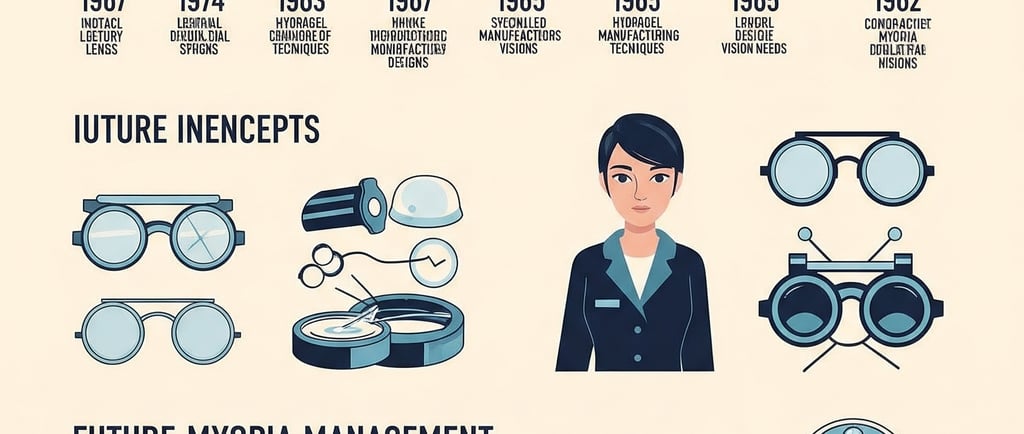The history of the development of contact lenses - Forecast of future myopia treatment trends
2/8/20257 min read


Introduction to Contact Lenses
Contact lenses are optical devices worn directly on the surface of the eye, designed primarily to correct refractive vision errors such as myopia (nearsightedness), hyperopia (farsightedness), astigmatism, and presbyopia (age-related farsightedness). Unlike traditional eyeglasses, which sit on the bridge of the nose and require specific adjustments for a proper fit, contact lenses conform to the curvature of the eye itself, providing a wider field of vision and reducing the visual obstructions that glasses can introduce.
The very essence of contact lenses lies in their ability to provide corrective vision that feels seamless and natural. They are particularly beneficial for individuals who lead active lifestyles or have professional demands that make wearing glasses less practical. Moreover, the cosmetic appeal of contact lenses cannot be overlooked; they offer a means for individuals to change their eye color or enhance their appearance while enjoying the freedom of unobstructed vision.
In today's society, the importance of vision correction is more pronounced than ever. With the growing prevalence of myopia, especially among younger populations, understanding the role and functionality of contact lenses has become essential. Factors such as increased screen time, limited outdoor activity, and genetic predispositions have fueled a surge in myopia cases globally. As such, the development and optimization of contact lenses continue to evolve, adapting to the unique needs of users.
As we explore the trajectory of contact lenses from their rudimentary beginnings to their sophisticated modern iterations, it is critical to consider how advancements in this field may potentially shape future treatment options for myopia, addressing an important public health concern. Understanding these developments will also provide insight into the innovations that lie ahead in vision care.
The Early History of Contact Lenses
The journey of contact lenses began in the 19th century, marking a significant milestone in the realm of vision correction. The earliest concept of a contact lens can be traced back to 1801, when the German philosopher and inventor, Johann Wolfgang von Goethe, suggested the use of a glass lens that could be placed directly on the eye. However, it was not until 1887 that the first tangible attempt at creating contact lenses was realized. A remarkable innovation by the Berlin-based optician, Adolf Fick, showcased the potential of these devices, as he developed a lens crafted from blown glass that molded the shape of the human cornea. This early design was not only revolutionary but also problematic due to its weight and discomfort.
In the years that followed, other scientists made significant contributions to the development of contact lenses. Notably, Hermann von Helmholtz, a prominent physicist and inventor, introduced the concept of utilizing a more comfortable and less intrusive lens. His research, particularly in optics and vision, laid the groundwork for future advancements in contact lens technology. By the early 20th century, further improvements were achieved with the development of lighter and more breathable materials, allowing for prolonged wear and greater comfort.
The introduction of scleral lenses in the early 1900s marked another advancement in contact lens innovation. These lenses, which covered not only the cornea but also a portion of the sclera, provided a means for those with severe vision impairments to achieve better visual acuity. As technology progressed, the materials used in the creation of contact lenses evolved. The introduction of plastics in the 1930s allowed for even lighter designs, making contact lens wearing a more viable option for a broader audience.
The early history of contact lenses illustrates a journey of experimentation and innovation that set the stage for the modern, high-tech lenses available today. As the understanding of optics continued to expand, it became clear that contact lenses would transform the way we approach vision correction, paving the way for future developments in myopia treatment.
Advancements in the 20th Century
The 20th century witnessed transformative advancements in contact lens technology, fundamentally reshaping the experience of vision correction. In the early decades, rigid gas-permeable (RGP) lenses emerged as a significant improvement over their predecessors. These lenses, crafted from a combination of plastic and oxygen-permeable materials, allowed for increased comfort and visual clarity. RGP lenses offered a more breathable alternative, reducing the discomfort often associated with traditional hard lenses while still providing excellent durability and stability in vision correction.
Further innovation came with the development of soft hydrogel lenses in the late 1960s. These lenses marked a monumental leap forward due to their flexibility and increased moisture retention, contributing to enhanced comfort for wearers. The introduction of soft lenses made it possible for a larger segment of the population to experience the freedom that contact lenses could provide, as they were significantly easier to adapt to compared to the rigid counterparts. This accessibility ultimately cultivated widespread acceptance of contact lenses as a viable option for vision correction.
The advent of disposable lenses in the 1980s further revolutionized the contact lens industry. By allowing users to wear lenses for a day and then dispose of them, this innovation not only improved hygiene but also reduced the length of time necessary for cleaning and maintenance. This ease of use fostered a new generation of wearers who preferred the convenience of disposables. The combination of advancements in materials and design, alongside innovations in manufacturing processes, solidified contact lenses as an integral part of optical care, increasing their popularity and accessibility among those requiring vision correction.
The Rise of Orthokeratology and Myopia Management
Orthokeratology, commonly referred to as ortho-k, has emerged as a prominent method for managing myopia, particularly among children and young adults. This innovative corrective technique involves the use of specially designed contact lenses that are worn overnight. These lenses gently reshape the cornea, which in turn reduces the degree of myopia experienced during the day. The effectiveness of ortho-k in controlling myopia progression has garnered significant interest in both clinical practice and among parents seeking effective solutions for their children's vision concerns.
The popularity of orthokeratology can be attributed to its non-invasive nature and the considerable comfort it offers users. Unlike traditional corrective lenses, ortho-k lenses allow individuals to achieve clear vision during waking hours without the need for glasses or daytime contact lenses, growing increasingly appealing, especially among active children and teenagers. Furthermore, studies indicate that this method does not only provide immediate visual acuity improvements but also plays a role in slowing the progression of myopia over time. This has made ortho-k a valuable tool in the broader context of myopia management, where the goal is to address not just the symptoms but also the underlying causes of myopic progression.
Current Innovations in Contact Lens Technology
The landscape of contact lens technology has advanced significantly in recent years, creating opportunities that extend well beyond traditional vision correction. Innovations such as smart contact lenses, which are equipped with various sensors and monitoring capabilities, are paving the way for a new era in vision care. These devices can monitor ocular health, track intraocular pressure, and even assist in managing chronic conditions such as diabetes through biochemical detection of glucose levels. By integrating these features directly into the lens, patients benefit from a non-invasive approach to health monitoring, making it a significant development in the realm of wearable technology.
In addition to smart lenses, augmented reality (AR) capabilities are emerging as a compelling innovation in contact lens technology. AR contact lenses could significantly enhance users' experiences by overlaying digital information onto their field of view, thereby merging the physical and virtual worlds. This could have profound implications for various fields, including education, gaming, and healthcare. As this technology advances, the potential for enhanced visual experiences becomes increasingly tangible, illustrating not only a step forward in contact lens functionality but also a fundamental shift in how we perceive and interact with our environment.
Moreover, therapeutic contact lenses are gaining attention for their ability to deliver medication directly to the eye. These innovative lenses can release drugs in a controlled manner, potentially improving treatment adherence and efficacy for conditions such as glaucoma and dry eye syndrome. The development of lenses integrated with adaptive optics technology is another area of exploration. This upcoming advancement aims to correct visions issues dynamically, allowing lenses to adjust focus in real-time according to environmental changes, ultimately redefining the standard for vision correction.
Forecasting Future Trends in Myopia Treatment
The ongoing evolution of myopia treatment reflects substantial advancements in both technology and understanding of the condition. One of the most promising avenues is gene therapy, an innovative approach that aims to address the genetic factors contributing to myopia. Researchers are exploring strategies to modify genes related to eye development and refractive error, potentially providing a long-term solution for individuals predisposed to myopia. As the field of genetics continues to advance, we may see more precise interventions that could significantly reduce the incidence of myopia, particularly in children.
In addition to gene therapy, pharmacological solutions are gaining attention as potential myopia management strategies. Currently, some eye drops containing atropine have shown efficacy in slowing the progression of myopia in children. Future research may focus on the development of new pharmaceuticals that target the biochemical pathways involved in eye growth and curvature, offering more effective means of controlling myopia rates among young populations. This pharmacological approach could complement existing methods, such as glasses and contact lenses, resulting in a multifaceted strategy for managing myopia.
Technological advancements, particularly in artificial intelligence (AI), are also poised to influence myopia treatment dramatically. AI algorithms can analyze vast amounts of data to predict individual cases of myopia progression, enabling personalized treatment plans tailored to each patient’s unique profile. These systems could help eye care professionals make more informed decisions and intervene earlier in the disease process, potentially mitigating severe outcomes. Furthermore, the introduction of smart contact lenses, equipped with sensors and connectivity, may allow continuous monitoring of eye health and refraction changes, thereby creating a dynamic management plan for individuals at risk of myopia.
In conclusion, the future of myopia treatment appears to be characterized by significant scientific developments, with gene therapy, pharmacological innovations, and cutting-edge technology converging to create a more effective and personalized approach to managing this common vision condition.
Conclusion and Final Thoughts
Throughout the history of contact lenses, we have witnessed significant advancements that have enhanced their usability and effectiveness. From the early glass lenses of the 19th century to the modern-day soft contacts and innovative designs aimed at treating specific eye conditions, the evolution of contact lenses reflects a remarkable journey of technological progress. This evolution is particularly relevant today as we face a global myopia epidemic, particularly among children and adolescents. Increasing screen time and reduced outdoor activities are contributing factors to this rise, leading to a critical need for improved treatment strategies.
Future trends indicate a promising trajectory for myopia treatment. With ongoing research dedicated to the prevention and management of myopia, we are seeing a growing interest in options such as orthokeratology and the development of contact lenses that deliver pharmaceuticals directly to the eye. These innovations not only aim to correct vision but also to address the underlying causes of myopia progression. Furthermore, the integration of technology, such as smart contact lenses equipped with sensors, may provide real-time data on visual health and facilitate personalized treatment strategies.
As the field of optometry continues to advance, the importance of innovation in contact lens technology cannot be overstated. Ongoing research and development are crucial in achieving better patient outcomes, maintaining overall eye health, and addressing the increasing prevalence of myopia on a global scale. Collaboration among researchers, eye care professionals, and manufacturers will be essential in transforming findings into practical solutions that benefit individuals affected by myopia. It is evident that the future of contact lenses is not only about vision correction but also about improving quality of life through proactive management of eye health.
